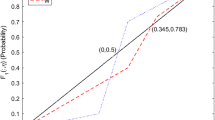Abstract
Stochastic dominance relations are well studied in statistics, decision theory and economics. Recently, there has been significant interest in introducing dominance relations into stochastic optimization problems as constraints. In the discrete case, stochastic optimization models involving second order stochastic dominance constraints can be solved by linear programming. However, problems involving first order stochastic dominance constraints are potentially hard due to the non-convexity of the associated feasible regions. In this paper we consider a mixed 0–1 linear programming formulation of a discrete first order constrained optimization model and present a relaxation based on second order constraints. We derive some valid inequalities and restrictions by employing the probabilistic structure of the problem. We also generate cuts that are valid inequalities for the disjunctive relaxations arising from the underlying combinatorial structure of the problem by applying the lift-and-project procedure. We describe three heuristic algorithms to construct feasible solutions, based on conditional second order constraints, variable fixing, and conditional value at risk. Finally, we present numerical results for several instances of a real world portfolio optimization problem.
Similar content being viewed by others
References
Balas, E.: Disjunctive programming: properties of the convex hull of feasible points. Technical report MSRR 348, Carnegie Mellon University (1974)
Balas, E.: Disjunctive programming: cutting planes from logical conditions. In: Mangasarian, O.L., Meyer, R.R., Robinson, S.M.(eds.), Nonlinear Programming 2, Academics Press, New York, 279–312 (1975)
Balas E. (1979). Disjunctive programming. Ann Discr. Math. 5: 3–51
Balas E., Ceria S. and Cornuèjols G. (1993). A lift-and-project cutting plane algorithm for mixed 0–1 programs. Math. Programm. 58: 295–324
Balas E., Ceria S. and Cornuèjols G. (1993). Solving mixed 0–1 programs by a lift-and-project method. SODA 1993: 232–242
Balas E., Ceria S. and Cornuèjols G. (1996). Mixed 0–1 programming by lift-and-project in a branch-and-cut framework. Manage. Sci. 42: 1229–1246
Balas, E., Perregaard, M.: Generating cuts from multiple-tem disjunctions. In: Aardal, K., Gerards, B. (eds.) Proceedings of IPCO VIII. Lecture Notes in Computer Science 2081, 348–360 (2001)
Blair C.E. and Jeroslow R.G. (1978). A converse for disjunctive constraints. J. Optim. Theory Appl. 25: 195–206
Ceria, S., Soares, J.: Disjunctive cut generation for mixed 0–1 programs: duality and lifting. Working Paper, Graduate School of Business, Columbia University (1997)
Dentcheva D. and Ruszczyński A. (2003). Optimization with stochastic dominance constraints. SIAM J. Optim. 14: 548–566
Dentcheva D. and Ruszczyński A. (2004). Optimality and duality theory for stochastic optimization problems with nonlinear dominance constraints. Math. Programm. 99: 329–350
Dentcheva D. and Ruszczyński A. (2004). Convexification of stochastic ordering. C. R. Acad. Bulgare Sci. 57(4): 7–14
Dentcheva D. and Ruszczyński A. (2004). Semi-infinite probabilistic optimization: first order stochastic dominance constraints. Optimization 53: 583–601
Dentcheva D. and Ruszczyński A. (2006). Portfolio optimization with first order stochastic dominance constraints. J. Banking Financ 30(2): 433–451
Fishburn P.C. (1970). Utility Theory for Decision Making. Wiley, New York
Fourer, R., Gay, D.M., Kernighan, B.W.: AMPL: A Modelling Language for Mathematical Programming. The Scientific Press (1993)
Hadar J. and Russell W. (1969). Rules for ordering uncertain prospects. Am. Econ. Rev. 59: 25–34
Hanoch G. and Levy H. (1969). The efficiency analysis of choices involving risk. Rev. Econ. Stud. 36: 335–346
Klatte D. and Henrion R. (1998). Regularity and stability in nonlinear semi-infinite optimization. Nonconvex optim. Appl. 25: 69–102
ILOG CPLEX: CPLEX 9.0 Users Manual and Reference Manual, ILOG CPLEX Division, Incline Village, NV (2005)
Klein Haneveld, W.K.: Duality in Stochastic Linear and Dynamic Programming. Lecture Notes in Economics and Mathematical Systems, Vol. 274. Springer, New York (1986)
Klein Haneveld W.K. and VanDer Vlerk M.H. (2006). Integrated chance constraints: reduced forms and an algorithm. Comput. Manage. Sci. 3(4): 245–269
Lehmann E. (1955). Ordered families of distributions. Ann. Math. Stat. 26: 399–419
Levy H. (1992). Stochastic dominance and expected utility: survey and analysis. Manage Sci. 38: 555–593
Mann H.B. and Whitney D.R. (1947). On a test of whether one of two random variables is stochastically larger than the other. Ann. Math. Stat. 18: 50–60
Markowitz H.M. (1952). Portfolio Selection. J. Finan. 7: 77–91
Markowitz H.M. (1959). Portfolio Selection. Wiley, New York
Noyan N., Rudolf G. and Ruszczyński A. (2005). Relaxations of linear programming problems with first order stochastic dominance constraints. Oper. Res. Lett. 103: 784–797
Noyan, N.: Optimization with first order stochastic dominance constraint. Doctoral Dissertation, Graduate School of New Brunswick, Rutgers, The State University of New Jersey, Piscataway, USA (2006)
Ogryczak W. and Ruszczyński A. (1999). From stochastic dominance to mean-risk models: semideviations as risk measures. Eur. J. Oper. Res. 116: 33–50
Ogryczak W. and Ruszczyński A. (2001). Dual stochastic dominance and related mean-risk models. SIAM J. Optim. 13: 60–78
Perregaard, M.: Generating disjunctive cuts for mixed integer programs. Doctoral Dissertation, Graduate School of Industrial Administration, Schenley Park, Pittsburgh, Carnegie Mellon University (2003)
Quirk J.P. and Saposnik R. (1962). Admissibility and measurable utility functions. Rev. Econ. Stud. 29: 140–146
Rockafellar R.T. and Uryasev S. (2000). Optimization of conditional value at risk. J. Risk 2: 21–41
Rothschild M. and Stiglitz J.E. (1969). Increasing risk: I. A definition. J. Econom. Theory 2: 225–243
Rudolf, G., Ruszczyński, A.: A dual approach to linear stochastic optimization problems with second order dominance constraints (in preparation) (2006)
Ruszczyński A. and Vanderbei R.J. (2003). Frontiers of stochastically nondominated portfolios. Econometrica 71: 1287–1297
Whitmore G.A. and Findlay M.C. (1978). Stochastic dominance: an approach to decision-making under risk. D.C.Heath, Lexington
Author information
Authors and Affiliations
Corresponding author
Additional information
This research was supported by the NSF awards DMS-0603728 and DMI-0354678.
Rights and permissions
About this article
Cite this article
Noyan, N., Ruszczyński, A. Valid inequalities and restrictions for stochastic programming problems with first order stochastic dominance constraints. Math. Program. 114, 249–275 (2008). https://doi.org/10.1007/s10107-007-0100-1
Received:
Accepted:
Published:
Issue Date:
DOI: https://doi.org/10.1007/s10107-007-0100-1




